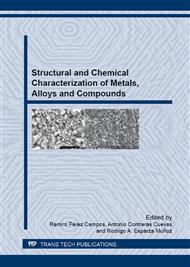[1]
J. Angenete, K. Stiller and E. Bakchinova, Microstructural and microchemical development of simple and Pt-modified aluminide diffusion coatings during long term oxidation at 1050 °C, Surf. Coat. Technol. 176 (2004) 272-283.
DOI: 10.1016/s0257-8972(03)00767-9
Google Scholar
[2]
J. Angenete, K. stiller, and V. Langer, Oxidation of Simple and Pt-Modified Aluminide Diffusion Coatings on Ni-Base Superalloys-I. Oxide Scale Microstructure, Oxidation of Metals 60 (2003) 47-82.
DOI: 10.1023/a:1024665229656
Google Scholar
[3]
D.K. Das, V. Singh, and S.V. Joshi: JOM Vol. 52 (2000), p.1.
Google Scholar
[4]
P.W. Schilke, GE Energy, Report GER-3569G (2004).
Google Scholar
[5]
Y.Q. Wang and G. Sayre, Factors affecting the microstructure of platinum-modified aluminide coatings during a vapor phase aluminizing process, Surf. Caot. Technol. 203 (2009) 1264-1272.
DOI: 10.1016/j.surfcoat.2008.10.031
Google Scholar
[6]
H.J. Kim, M.E. Walter, Characterization of the degraded microstructures of a platinum aluminide coating, Mater. Sci. Eng. A 360 (2003) 7-17.
Google Scholar
[7]
A. Littner, F. Pedraza, A.D. Kennedy, P. Moretto, L. Peichl, T. Weber and M. Schuetze, Performance and thermal stability of Pt-modified Al-diffusion coatings for superalloys under cyclic and isothermal conditions, Mat. High Temp. 22 (2005).
DOI: 10.3184/096034005782744308
Google Scholar
[8]
H.M. Tawancy, N. Sridhar, N.M. Abbas and D.S. Rickerby, Comparative performance of selected bond coats in advanced thermal barrier coating systems, J. Mat. Sci. 35 (2000) 3615-3629.
DOI: 10.1023/a:1004825932601
Google Scholar
[9]
Y.H. Zhang, D.M. Knowles and P.J. Withers, Microstructural development in Pt-aluminide coating on CMSX-4 superalloy during TMF, Surf. Coat. Technol. 107 (1998) 76-83.
DOI: 10.1016/s0257-8972(98)00579-9
Google Scholar
[10]
M. Yavorska and J. Sieniawski, Oxidation behaviour of platinum modified aluminide coatings deposited by CVD method on nickel-based superalloys under air atmosphere, Journal of Achievements in Materials and Manufacturing Engineering 46 (2011).
DOI: 10.2478/v10172-012-0052-1
Google Scholar
[11]
Vladimir K. Tolpygo, Development of internal cavities in platinum-aluminide coatings during cyclic oxidation, Surf. Coat. Technol. 202 (2007) 617-622.
DOI: 10.1016/j.surfcoat.2007.07.072
Google Scholar
[12]
D.K. Das, Vankil Singh and S.V. Joshi, Effect of prealuminizing diffusion treatment on microstructural evolution of high-activity pt-aluminide coatings, Metall. Mater. Trans. A 31 (2000) 2037-(2047).
DOI: 10.1007/s11661-000-0231-y
Google Scholar
[13]
L.C. Zhang and A.H. Heuer, Microstructural evolution of the nickel platinum-aluminide bond coat on electron-beam physical-vapor deposition thermal-barrier coatings during high-temperature service, Metall. Mater. Trans. A 36 (2005) 43-53.
DOI: 10.1007/s11661-005-0137-9
Google Scholar
[14]
J. Allen Haynes, Potential influences of bond coat impurities and void growth on premature failure of EB-PVD TBCs, Scripta. Mater. 44 (2001) 1147-1152.
DOI: 10.1016/s1359-6462(00)00703-x
Google Scholar
[15]
G. Moskal, Thermal barrier coatings: characteristics of microstructure and properties, generation and directions of development of bond, Journal of Achievements in Materials and Manufacturing Engineering 37 (2009) 323-331.
Google Scholar
[16]
Josh Kimmel, Evaluation of composition and phases in platinum aluminide diffusion coatings, Mats. Solids in Nature 290 (2000) 1.
Google Scholar
[17]
Y. Niu. W.T. Wu, D.H. Boone, J.S. Smith, J.Q. Zhang and C.L. Zhen, Oxidation behaviour of simple and Pt-modified aluminide coatings on IN738 at 1100 °C, Journal de Physique IV 3 (1993) 511-520.
DOI: 10.1051/jp4:1993954
Google Scholar
[18]
N.M. Yanar, G. M. Kim, F.S. Pettit and G.H. Meier, Report of the Chungnam National University, Department of Materials Science and Engineering, University of Pittsburg (2004).
Google Scholar
[19]
H. Svensson, J. Angenete, K. Stiller, Microstructure of oxide scales on aluminide diffusion coatings after short time oxidation at 1050 °C, Surf. Coat. Technol. 177 (2004) 152-157.
DOI: 10.1016/j.surfcoat.2003.09.002
Google Scholar


